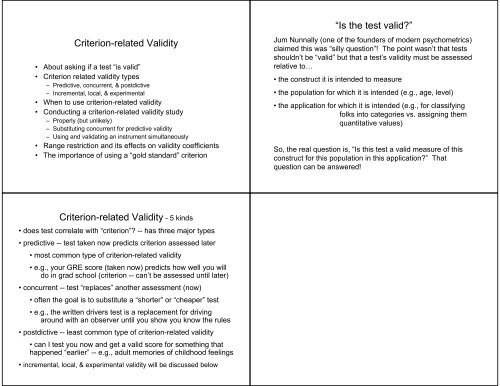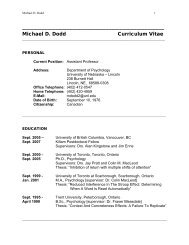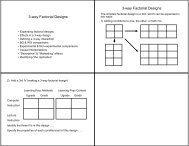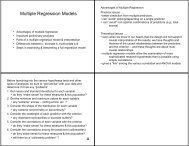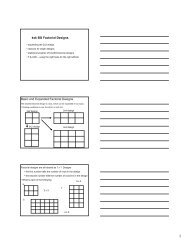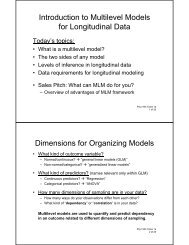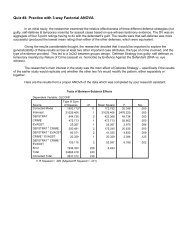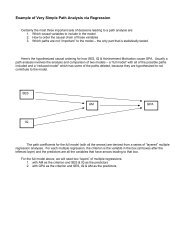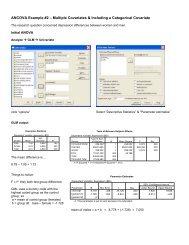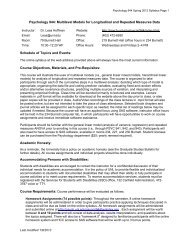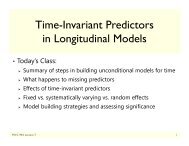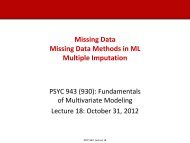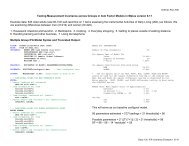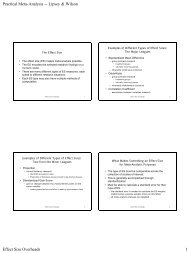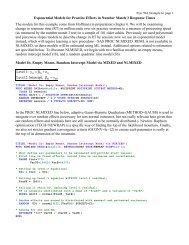Criterion-related Validity “Is the test valid?†Criterion-related Validity ...
Criterion-related Validity “Is the test valid?†Criterion-related Validity ...
Criterion-related Validity “Is the test valid?†Criterion-related Validity ...
- No tags were found...
Create successful ePaper yourself
Turn your PDF publications into a flip-book with our unique Google optimized e-Paper software.
The advantage of criterion-<strong>related</strong> <strong>valid</strong>ity is that it is a relativelysimple statistically based type of <strong>valid</strong>ity!• If <strong>the</strong> <strong>test</strong> has <strong>the</strong> desired correlation with <strong>the</strong> criterion, <strong>the</strong>nyou have sufficient evidence for criterion-<strong>related</strong> <strong>valid</strong>ity.There are, however, some limitations to criterion-<strong>related</strong> <strong>valid</strong>ity…• It is dependent upon your having a criterion•Sometimes you don’t have a criterion variable to use --e.g., first <strong>test</strong> of construct that is developed• It is dependent upon <strong>the</strong> quality of <strong>the</strong> criterion variable•Sometimes <strong>the</strong>re are “limited” or “competing” criteria• “Correlation is not equivalence”•your <strong>test</strong> that is cor<strong>related</strong> with <strong>the</strong> criterion might also becor<strong>related</strong> with several o<strong>the</strong>r variables -- what doesit “measure” ?Conducting a Predictive <strong>Validity</strong> Studyexample -- <strong>test</strong> designed to identify qualified “front deskpersonnel” for a major hotel chain-- 200 applicants - and 20 position openingsConducting <strong>the</strong> “proper study”• give each applicant <strong>the</strong> <strong>test</strong> (and “seal” <strong>the</strong> results)• give each applicants a job working at a front desk• assess work performance after 6 months (<strong>the</strong> criterion)• correlate <strong>the</strong> <strong>test</strong> (predictor) and work performance (criterion)Anybody see why <strong>the</strong> chain might not be willing to apply thisdesign?Here are two designs often substituted for this proper design.Substituting concurrent <strong>valid</strong>ity for predictive <strong>valid</strong>ity• assess work performance of all folks currently doing <strong>the</strong> job• give <strong>the</strong>m each <strong>the</strong> <strong>test</strong>• correlate <strong>the</strong> <strong>test</strong> (predictor) and work performance (criterion)Problems?• Not working with <strong>the</strong> population of interest (applicants)• Range restriction -- work performance and <strong>test</strong> scorevariability are “restricted” by this approach• current hiring practice probably not “random”• good workers “move up” -- poor ones “move out”• Range restriction will artificially lower <strong>the</strong> <strong>valid</strong>ity coefficient (r)
What happens to <strong>the</strong>sample ...What happens to <strong>the</strong> <strong>valid</strong>itycoefficient -- rApplicant pool -- target populationSelected (hired) folks• assuming selection basis is somewhat reasonable/functionalSample used in concurrent <strong>valid</strong>ity study• worst of those hired have been “released”• best of those hired have “changed jobs”Applicant poolr = .75Hired FolksSample used in<strong>valid</strong>ity studyr = .20<strong>Criterion</strong> - job performancePredictor -- interview/measureUsing and <strong>test</strong>ing predictive <strong>valid</strong>ity simultaneously• give each applicant <strong>the</strong> <strong>test</strong>• give those applicants who “score well” a front desk job• assess work performance after 6 months (<strong>the</strong> criterion)• correlate <strong>the</strong> <strong>test</strong> (predictor) and work performance (criterion)Problems?• Not working with <strong>the</strong> population of interest (all applicants)• Range restriction -- work performance and <strong>test</strong> scorevariability are “restricted” by this approach• only hired good those with “better” scores on <strong>the</strong> <strong>test</strong>• (probably) hired those with “better” work performance• Range restriction will artificially lower <strong>the</strong> <strong>valid</strong>ity coefficient (r)• Using a <strong>test</strong> before its <strong>valid</strong>ated can have “legal ramifications”
O<strong>the</strong>r kinds of criterion-<strong>related</strong> <strong>valid</strong>ity…Incremental <strong>Validity</strong>Asks if <strong>the</strong> <strong>test</strong> “improves on” <strong>the</strong> criterion-<strong>related</strong> <strong>valid</strong>ity ofwhatever <strong>test</strong>s are currently being used.Example. I claim that scores from my new structured interviewwill lead to more accurate selection of gradua<strong>test</strong>udents. I’m not suggesting you stop using what youare using, but ra<strong>the</strong>r that you ADD my interview.Demonstrating Incremental <strong>Validity</strong> requires we show that <strong>the</strong>“new <strong>test</strong> + old <strong>test</strong>s” do better than “old <strong>test</strong>s alone”. R²Δ <strong>test</strong>…R² grad. grea, grev, greq = .45R² grad. Grea, grev, greq, interview = .62Incremental <strong>valid</strong>ity is .17 (or 38% increase)Local <strong>Validity</strong>Explicit check on <strong>valid</strong>ity of <strong>the</strong> <strong>test</strong> for your population andapplication.Sounds good, but likely to have <strong>the</strong> following problems• Sample size will be small (limited to your “subject pool”)• Study will likely be run by “semi-pros”• Optimal designs probably won’t be used (e.g., predictive <strong>valid</strong>ity)• Often (not always) this is an attempt to “bend” <strong>the</strong> use of anestablished <strong>test</strong> to a population/application for which it wasnot designed nor previously <strong>valid</strong>atedExperimental <strong>Validity</strong>A study designed to show that <strong>the</strong> <strong>test</strong> “reacts” as it should to aspecific treatment.In <strong>the</strong> “usual experiment,” we have confidence that <strong>the</strong> DVmeasures <strong>the</strong> construct in which we are interested, and we are<strong>test</strong>ing if <strong>the</strong> IV is <strong>related</strong> to that DV (that we trust).In Experimental <strong>Validity</strong>, we have confidence in <strong>the</strong> IV (treatment)and want to know if <strong>the</strong> DV (<strong>the</strong> <strong>test</strong> being <strong>valid</strong>ated) will respond“as it should” to this treatment.Example: I have this new index of social anxiety I know that aparticular cognitive-behavioral treatment has a long, successfulhistory of treating social anxiety. My experimental <strong>valid</strong>ity studyinvolves pre- and post-<strong>test</strong>ing 50 participants who receive thistreatment -- experimental criterion-<strong>related</strong> <strong>valid</strong>ity would bedemonstrated by a pre-post score difference (in <strong>the</strong> right direction)
Thinking about <strong>the</strong> procedures used to assesscriterion <strong>related</strong> <strong>valid</strong>ity…All <strong>the</strong> types of criterion <strong>related</strong> <strong>valid</strong>ity involved correlating <strong>the</strong>new measure/instrument with some selected criterion• large correlations indicate criterion <strong>related</strong> <strong>valid</strong>ity (.5-.7)• smaller correlations are interpreted to indicate <strong>the</strong> limited<strong>valid</strong>ity of <strong>the</strong> insrument(As mentioned before) This approach assumes you have a criterionthat really is a “gold standard” of what you want to measure.• Even when such a measure exists it will itself probably havelimited <strong>valid</strong>ity and reliability• We will consider each of <strong>the</strong>se and how <strong>the</strong>y limit <strong>the</strong>conclusions we can draw about <strong>the</strong> criterion <strong>related</strong> <strong>valid</strong>ityof our instrument from correlational analysesLet’s consider <strong>the</strong> impact of limited <strong>valid</strong>ity of <strong>the</strong> criterion upon<strong>the</strong> assessment of <strong>the</strong> criterion <strong>related</strong> <strong>valid</strong>ity of <strong>the</strong> newinstrument/measure• let’s assume we have a “perfect” measure of <strong>the</strong> construct• if <strong>the</strong> criterion we plan to use to <strong>valid</strong>ate our new measureis “really good” it might itself have a <strong>valid</strong>ity as high as,say .8 -- shares 64% of its variability with perfect measure• here are two hypo<strong>the</strong>tical “new measures” - which is more <strong>valid</strong>?• Measure 1 -- r with criterion = .70 (49% overlap)• Measure 2 -- r with criterion = .50 (25% overlap)Measure 1 has <strong>the</strong> higher <strong>valid</strong>itycoefficient, but <strong>the</strong> weaker relationshipwith <strong>the</strong> perfect measureMeasure 2 has <strong>the</strong> stronger relationshipwith <strong>the</strong> perfect measure, but looks badbecause of <strong>the</strong> choice of criterionSo, <strong>the</strong> meaningfulness of a <strong>valid</strong>ity coefficient is dependent upon<strong>the</strong> “quality” of <strong>the</strong> criterion used for assessmentBest case scenario …• criterion is objective measure of <strong>the</strong> specific behavior of interest• when <strong>the</strong> measure IS <strong>the</strong> behavior we are interested in, notsome “representation”• e.g., graduate school GPA, hourly sales, # publicationsTougher situation …• objective measure of behavior “represents” construct of interest,but isn’t <strong>the</strong> specific behavior of interest• e.g., preparation for <strong>the</strong> professorate, sales skill, contributionto <strong>the</strong> department• notice each of <strong>the</strong> measures above is an incompleterepresentation of <strong>the</strong> construct listed hereHorror show …• subjective (potentially biased) rating of behavior or performance• advisor’s eval, floor manager’s eval, Chair’s evaluations
Now let’s consider <strong>the</strong> relationship between reliability & <strong>valid</strong>ity…“reliability is a precursor for <strong>valid</strong>ity”• conceptually -- how can a measure be consistently accurate(<strong>valid</strong>), unless it is consistent ??• internal consistency -- all items reflect <strong>the</strong> same construct• <strong>test</strong>-re<strong>test</strong> consistency -- scale yields repeatable scores• statistically -- limited reliability means that some of <strong>the</strong> variabilityin <strong>the</strong> measure is systematic, but part isunsystematic (unreliable)• low reliability will “attenuate” <strong>the</strong> <strong>valid</strong>ity correlation• much like range restriction -- but this is a restriction of <strong>the</strong>“systematic variance”, not <strong>the</strong> overall varianceVarious “correction for attenuation” formulas…Note: y=criterion x=measure being assessed ‘ = estimate• estimates what would be <strong>the</strong> <strong>valid</strong>itycoefficient if both <strong>the</strong> criterion and <strong>the</strong>measure were perfectly reliable(α=1.00)• estimates what would be <strong>the</strong> <strong>valid</strong>ity if <strong>the</strong>criterion were perfectly reliable• a more useful formula estimates <strong>the</strong> <strong>valid</strong>itycoefficient if each measure’s reliability“improved” to a specific valuer YXr YX ’ = --------------√α Y * √α Xr YXr YX ’ = -----√α Y“improved” αsit is possible to statistically “correct” for this attenuation-- like all “statistical correction”, this must be carefully applied!Measured <strong>valid</strong>ity√α Y ’ * √α X ’r YX ’= r YX --------------√α Y * √α Xmeasured αsExample …You have constructed an interview which is designed to predictemployee performance• scores on this interview (X) correlate .40 with supervisor’s ratings (Y)• <strong>the</strong> interview has an α Y = .50• <strong>the</strong> supervisor rating scale (<strong>the</strong> criterion) has α X= .70Correcting both <strong>the</strong> interviewand criterion to perfectreliability...Correcting just <strong>the</strong> to perfectreliability ...r YX.40r YX ’ = ----------- = ------------ = .68√α Y * √α X √.70 * √50r YX.40r YX ’ = ------------ = ------------ = .48√α Y √.70Correcting <strong>the</strong> interview toα=.7 to and criterion to α=.9...√α Y’ *√α X’ √.90 *√.70r YX’= r YX------------- = .40 ------------- = .53√α Y * √α X √.70 * √.50
So, What’s our best estimate of <strong>the</strong> “true” criterion-<strong>related</strong> <strong>valid</strong>ityof our instrument -- .40 ?? .48 ?? .53 ?? .68 ??Hmmmmmm….One must use <strong>the</strong>se “correction” formulas with caution !Good uses…• ask how <strong>the</strong> <strong>valid</strong>ity would be expected to change if <strong>the</strong> reliabilityof <strong>the</strong> new measure were increased to a certain value, as aprelude to working to increase <strong>the</strong> reliability of <strong>the</strong> new measuresto that reliability (adding more good items)• ask how <strong>the</strong> <strong>valid</strong>ity would be expected to change if <strong>the</strong> reliabilityof <strong>the</strong> criterion were increased to a certain value, as a prelude tofinding a criterion with this increased reliability“Poorer uses…”• using only <strong>the</strong> corrected values to evaluate <strong>the</strong> measure’s<strong>valid</strong>ity (remember, “best case” seldom represents “best guess” !)


